海岸动力学-严以新-习题讲解学习
海岸动力学 内容汇总 (1)
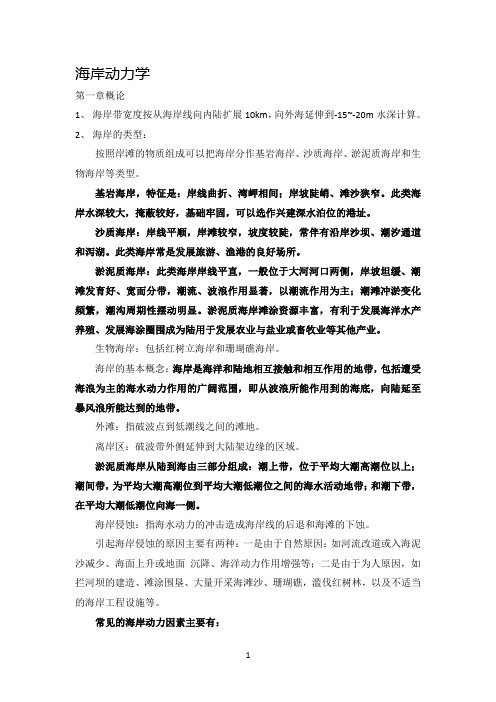
海岸动力学第一章概论1、海岸带宽度按从海岸线向内陆扩展10km,向外海延伸到-15~-20m水深计算。
2、海岸的类型:按照岸滩的物质组成可以把海岸分作基岩海岸、沙质海岸、淤泥质海岸和生物海岸等类型。
基岩海岸,特征是:岸线曲折、湾岬相间;岸坡陡峭、滩沙狭窄。
此类海岸水深较大,掩蔽较好,基础牢固,可以选作兴建深水泊位的港址。
沙质海岸:岸线平顺,岸滩较窄,坡度较陡,常伴有沿岸沙坝、潮汐通道和泻湖。
此类海岸常是发展旅游、渔港的良好场所。
淤泥质海岸:此类海岸岸线平直,一般位于大河河口两侧,岸坡坦缓、潮滩发育好、宽而分带,潮流、波浪作用显著,以潮流作用为主;潮滩冲淤变化频繁,潮沟周期性摆动明显。
淤泥质海岸滩涂资源丰富,有利于发展海洋水产养殖、发展海涂圈围成为陆用于发展农业与盐业或畜牧业等其他产业。
生物海岸:包括红树立海岸和珊瑚礁海岸。
海岸的基本概念:海岸是海洋和陆地相互接触和相互作用的地带,包括遭受海浪为主的海水动力作用的广阔范围,即从波浪所能作用到的海底,向陆延至暴风浪所能达到的地带。
外滩:指破波点到低潮线之间的滩地。
离岸区:破波带外侧延伸到大陆架边缘的区域。
淤泥质海岸从陆到海由三部分组成:潮上带,位于平均大潮高潮位以上;潮间带,为平均大潮高潮位到平均大潮低潮位之间的海水活动地带;和潮下带,在平均大潮低潮位向海一侧。
海岸侵蚀:指海水动力的冲击造成海岸线的后退和海滩的下蚀。
引起海岸侵蚀的原因主要有两种:一是由于自然原因:如河流改道或入海泥沙减少、海面上升或地面沉降、海洋动力作用增强等;二是由于为人原因,如拦河坝的建造、滩涂围垦、大量开采海滩沙、珊瑚礁,滥伐红树林,以及不适当的海岸工程设施等。
常见的海岸动力因素主要有:波浪的作用,波浪是引起海岸变化的主要原因;海岸波生流:斜向入射的波浪进入海滨地带后,在破波带引起一股与岸线平行的平均流,即沿岸流。
波浪在传向海岸的过程中会导致海岸水域出现流体质量的汇聚,这包括波浪由离岸水域传入破波带伴随着质量输移流向海岸汇集;方向相对的沿岸流在交汇点产生流体质量汇聚。
海岸动力学

海岸P4 海洋和陆地相互接触和相互作用的地带,包括遭受波浪为主的海水动力作用的广阔范围,即从波浪所能产生作用到的海底,向陆地延至暴风浪所能达到的地带。
海滩平衡剖面P193 在一定条件下,海滩上任一点的泥沙均没有净位移,剖面形状维持不变的海滩形态。
深水波P28如果海域水足够深,因而水底不影响表面波浪运动时,这时的波浪称为深水波否则为有限波或浅水波浅水波P28 是指水深h相对波长λ很小时(一般取h<1/20λ)的波动,又称长波有效波高P55又称三分之一大波,按波高大小次序排列后,取前面的1/3个波的平均波高和平均周期风暴潮P21 是指由台风、温度气旋、冷锋的强风作用和气压骤变等强烈的天气系统引起的海面异常升降,使受其影响的海区潮位大大地超过平均潮位的现象,又称风暴增水、风暴海啸、气象海啸或风潮。
破波角P80 破碎点处的波向线与岸线的外法线间的夹角波浪绕射P72 波浪在传播过程中遇到障碍物如防波堤、岛屿或大型墩柱,除可能在障碍物前产生波浪反射外,还将绕过障碍物继续传播,并在掩蔽区内发生波浪扩散,这是由于掩蔽区内波能横向传播所造成,这种现象称为波浪绕射。
潮间带P5 平均大潮高潮位到平均大潮低潮位之间的海水活动地带,即高潮被淹,低潮露出的海滩(潮滩)。
人工养滩P237 通常用于侵蚀型海岸的一种工程措施,即从海中或陆地上的沙源采砂后填筑于海滩上,以弥补被侵蚀的泥沙。
浮泥P217 在大风浪平息以后不久,上层水体含沙量逐渐减小,垂向出现清浊水交界面,底部形成高含沙量淤泥层,在潮流和风浪作用下,这层高含沙量淤泥,具有一定的流动性。
硬防护P231是指在海岸建筑固体的海岸工程建筑物来对海岸进行防护包括海岸、丁坝、离岸堤等建筑物。
软防护P231 是指利用自然沙为原料进行海滩人工喂养、人工输沙和建造人工海滩等以恢复海岸自然状态为目的的海岸防护措施。
简答题1淤泥质海岸的主要特征?P2答:岸线平直、一般位于大河河口两侧;岸坡坦缓、潮滩发育好、宽而分带;潮流、波浪作用显著,以潮流作用为主;潮滩冲淤变化频繁、潮沟周期性摆动明显。
海岸动力学

第一章1. ▲按波浪形态可分为规则波和不规则波。
2. 按波浪破碎与否波浪可分为:破碎波,未破碎波和破后波3. ★根据波浪传播海域的水深分类:①h/L=0.5深水波与有限水深波界限②h/L=0.05有限水深波和浅水波的界限,0.5>h/L>0.05为有限水深;h/L < 0.05为浅水波。
4. 波浪运动描述方法:欧拉法和拉格朗日法: 描述理论:微幅波理论和斯托克斯理论5. 微幅波理论的假设:①假设运动是缓慢的u远小于0, w远小于0②波动的振幅a远小于波长L 或水深h,即H或a远小于L和h。
6. (1)基本参数:①空间尺度参数:波高H:波谷底至波峰顶的垂直距离;振幅a:波浪中心至波峰顶的垂直距离;波面n =n(x,波面至静水面的垂直位移;波长L:两个相邻波峰顶之间的水平距离;水深h:静水面至海底的垂直距离②时间尺度参数:波周期T:波浪推进一个波长所需的时间;波频率f :单位时间波动次数f=1/T:波速c:波浪传播速度c=L/T(2)复合参数:①波动角(圆濒率?=2 n /②波数k=2 n③波陡S =H/④相对水深h/L或kh7. (1)势波运动的控制方程(拉普拉斯方程)⑵伯努利方程8. 定解条件(边界条件):①在海底表面水质点垂直速度为零,面z=n处,应满足两个边界条件:动力边界条件:自由水面水压力为0;运动边界条件:波面的上升速度与水质点上升速度相同。
自由水面运动边界条件:-③波Bt 加诡ii场上、下两端面边界条件:对于简单波动,常认为它在空间和时间上呈周期性。
29. ①自由水面的波面曲线:n =cos(k?t)*H/2②弥散方程:? =gktanh(kh)③弥散方程推得的几个等价关系式:L= tanh(kh)*gT /(2 n ), c= tanh(kh)*gT/(2 = tan n(kh:)*g/k10. ★弥散(色散)现象:水深给定时,波周期愈长,波长愈长,波速愈大,这样使不同波长的波在传播过程中逐渐分离。
海岸动力学复习题
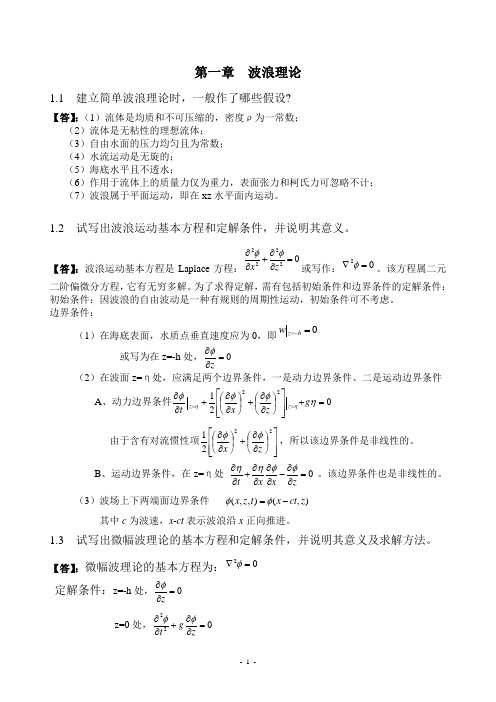
第一章 波浪理论1.1 建立简单波浪理论时,一般作了哪些假设?【答】:(1)流体是均质和不可压缩的,密度ρ为一常数;(2)流体是无粘性的理想流体; (3)自由水面的压力均匀且为常数; (4)水流运动是无旋的; (5)海底水平且不透水;(6)作用于流体上的质量力仅为重力,表面张力和柯氏力可忽略不计; (7)波浪属于平面运动,即在xz 水平面内运动。
1.2 试写出波浪运动基本方程和定解条件,并说明其意义。
【答】:波浪运动基本方程是Laplace 方程:02222=∂∂+∂∂z x φφ或写作:02=∇φ。
该方程属二元二阶偏微分方程,它有无穷多解。
为了求得定解,需有包括初始条件和边界条件的定解条件:初始条件:因波浪的自由波动是一种有规则的周期性运动,初始条件可不考虑。
边界条件:(1)在海底表面,水质点垂直速度应为0,即=-=h z w或写为在z=-h 处,0=∂∂zφ(2)在波面z=η处,应满足两个边界条件,一是动力边界条件、二是运动边界条件 A 、动力边界条件02122=+⎥⎥⎦⎤⎢⎢⎣⎡⎪⎭⎫ ⎝⎛∂∂+⎪⎭⎫ ⎝⎛∂∂+∂∂==ηφφφηηg z x tz z由于含有对流惯性项⎥⎥⎦⎤⎢⎢⎣⎡⎪⎭⎫ ⎝⎛∂∂+⎪⎭⎫ ⎝⎛∂∂2221z x φφ,所以该边界条件是非线性的。
B 、运动边界条件,在z=η处0=∂∂-∂∂∂∂+∂∂zx x t φφηη。
该边界条件也是非线性的。
(3)波场上下两端面边界条件 ),(),,(z ct x t z x -=φφ 其中c 为波速,x -ct 表示波浪沿x 正向推进。
1.3 试写出微幅波理论的基本方程和定解条件,并说明其意义及求解方法。
【答】:微幅波理论的基本方程为:02=∇φ定解条件:z=-h 处,0=∂∂zφz=0处, 022=∂∂+∂∂z g tφφz=0处,⎪⎭⎫⎝⎛∂∂-=t g φη1),(),,(z ct x t z x -=φφ求解方法:分离变量法 1.4 线性波的势函数为()[]()()t kx kh z h k gH σσφ-⋅+⋅=sin cosh cosh 2, 证明上式也可写成()[]()()t kx kh z h k Hc σφ-⋅+⋅=sin sinh cosh 2 【证明】: 由弥散方程:()kh gk tanh 2⋅=σ以及波动角频率σ和k 波数定义: T πσ2=, Lk π2= 可得:()kh Lg T tanh 22ππσ⋅=⋅, 即 ()()kh kh L T g cosh sinh ⋅⋅=σ 由波速c 的定义:TLc =故:()()c kh g kh sinh cosh ⋅=⋅σ 将上式代入波势函数: ()[]()()t kx kh z h k gH σσφ-⋅+⋅=sin cosh cosh 2 得: ()[]()()t kx kh z h k Hc σφ-⋅+⋅=sin sinh cosh 2 即证。
海岸动力学课件 4.2
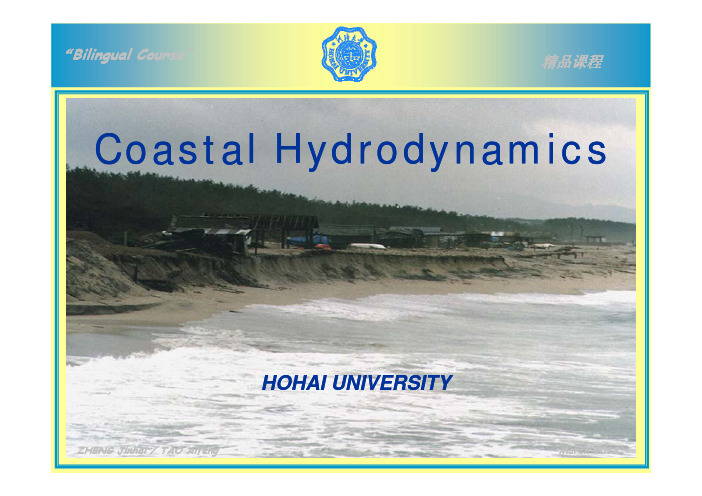
The pressure gradient of the sloping water
surface balances the change of the incoming
momentum. There is therefore a change in
mean water surface slope whenever there
3. Applications Radiation stress has been proved to be a very
powerful tool in the study of a variety of
oceanographic phenomena. In the context of
littoral processes, it has been used to predict
4/33
Chapter 4
The radiation stress across the plane x=constant in the direction of wave advance is
The radiation stress of y-momentum across the plane y=constant
This was prompted by the agreement between
two seemingly independent estimates of the
change of wave momentum by breaking across
the shoreline.
16/33
Chapter 4
The maximum value of wave set-up at the shoreline is
海岸动力学-严以新-习题讲解学习
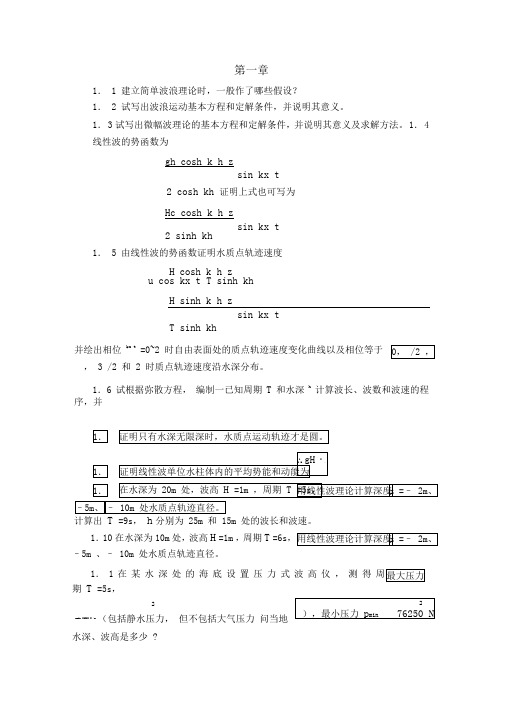
第一章1. 1 建立简单波浪理论时,一般作了哪些假设?1. 2 试写出波浪运动基本方程和定解条件,并说明其意义。
1. 3 试写出微幅波理论的基本方程和定解条件,并说明其意义及求解方法。
1. 4 线性波的势函数为 gh cosh k h zsin kx t2 cosh kh 证明上式也可写为 Hc cosh k h zsin kx t 2 sinh kh1. 5 由线性波的势函数证明水质点轨迹速度H cosh k h z u cos kx t T sinh kh H sinh k h zsin kx tT sinh kh并绘出相位 kx t =0~2 时自由表面处的质点轨迹速度变化曲线以及相位等于 , 3 /2 和 2 时质点轨迹速度沿水深分布。
1.6 试根据弥散方程, 编制一已知周期 T 和水深 h 计算波长、波数和波速的程序,并计算出 T =9s , h 分别为 25m 和 15m 处的波长和波速。
1.10 在水深为 10m 处,波高 H =1m ,周期 T =6s , –5m 、– 10m 处水质点轨迹直径。
1. 1 在 某 水 深 处 的 海 底 设 置 压 力 式 波 高 仪 , 测 得 周 期 T =5s ,2pmax 85250 N /m (包括静水压力, 但不包括大气压力 问当地水深、波高是多少 ?0, /2 , 1. 证明只有水深无限深时,水质点运动轨迹才是圆。
1. 证明线性波单位水柱体内的平均势能和动能为116 gH 2。
1. 在水深为 20m 处,波高 H =1m ,周期 T =5s, 用线性波理论计算深度 z =– 2m 、 –5m 、 – 10m 处水质点轨迹直径。
用线性波理论计算深度 z =– 2m 、 最大压力 2 ),最小压力 p min 76250 N1.12 若波浪由深水正向传到岸边,深水波高H 0 2m,周期T 10s ,问传到 lkm长的海岸上的波浪能量(以功率计)有多少?设波浪在传播中不损失能量。
海岸动力学

(二)大陆坡
东海、 东海、台湾以东海域与南海东部的 陡窄的阶梯状大陆坡与海槽、 陡窄的阶梯状大陆坡与海槽、海沟相伴 存在。南海的大陆坡多呈阶梯状, 存在。南海的大陆坡多呈阶梯状,坡底 水深范围在800 800~ m,坡度2 40', 水深范围在800~4 200 m,坡度2°40', 最大坡度达4 最大坡度达4°。
平均为67×10-3 mL/L, 地球上99%以上的溴 都储存在海水里,故 溴有“海洋元素”之 称。 的浓度只有0.06× 10-6,属于微量元 素。 以上。海水中所含 钾的储量远远超过 钾盐矿物储量。
铀海水中的总
量非常可观,达 45×108 t,相当于 陆地储量的4500倍。
镁在海水中
含量很高,仅次于 氯和钠,居第3位。
地下卤水资源是渗漏到地下的浓缩海水, 地下卤水资源是渗漏到地下的浓缩海水,其浓度一般比海水高 从中不仅可提取氯化钠、氯化钾、芒硝等,而且含有溴、 2~6倍,从中不仅可提取氯化钠、氯化钾、芒硝等,而且含有溴、 铜等多种元素。据调查,莱州湾沿海、河北、天津、 碘、铀、锶、铜等多种元素。据调查,莱州湾沿海、河北、天津、 辽宁沿海地区均有地下卤水发现。 辽宁沿海地区均有地下卤水发现。
台湾岛以东海域
二、海底地貌
渤海、黄海、东海海盆,位于亚欧板块与太平洋板块之间,南海海 盆处于亚欧板块与太平洋板块、印度洋板块的交接地带。这些板块的运 动建造了中国海域的地质格局。在此基础上,环海陆地上的河流把丰富 的物质输送入海,沉积到海底,进一步改造了海底的形态。 中国近海海域的海底地势大体由西北向东南渐趋加深。若将海南岛 南侧经台湾岛至五岛列岛连成一线,则此线的西北部分构成平缓的大陆 架区,而此线东南,则为大陆坡、海槽、深海盆以及岛缘大陆架。
浙江大学《海岸动力学》考点

【名词解说】(15 题× 2 分=30 分)第 2 章1.海浪:风作用于海面产生的风波2.涌浪:风停息后海面上仍旧存在的波涛或风波挪动到风区之外的波涛。
3.规则波不规则波 / 随机波涛 : 规则波波形规则,拥有显然的波峰波谷,二维性质明显。
不规则波波形凌乱,波高,波周期和波涛流传方向不定,空间上拥有显然三维性质。
4.混淆浪:风波和涌浪叠加形成的波涛5.深水波,浅水波,有限水深波 : 深水波 h/L 大于 1/2 、浅水波 h/L 小于 1/20 、其之间的称为有限水深波6.振荡波:颠簸中水质点环绕其静止地点沿着某种固有轨迹作周期性的来会来去运动,质点经过一个周期后没有显然的向前推移的波涛。
7.推动波 : 振荡波中若其波剖面对某一参照点作水平运动,波形不停向前推移的波涛。
8.立波 : 振荡波中若波剖面无水平运动,波形不再推动,只有上下振荡的波涛。
9.推移波: 颠簸中水质点只朝波涛流传方向运动,在任一时辰的任一断面上,沿水深的各质点拥有几乎同样的速度的波涛。
10.振幅:波涛中心至波峰顶的垂直距离;波高:波谷底至波峰顶的垂直距离11.波长:两个相邻波峰顶之间的水平距离12.波周期:波涛推动一个波长距离所需要的时间13.波速、波数、波频等观点。
14.波的色散现象:不一样波长(或周期)的波以不一样速度进行流传最后致使波的分别的现象15.波能流 : 波涛在流传过程中经过单宽波峰线长度的均匀的能量传达率16.波能:波涛在流传过程中单宽波峰线长度一个波长范围内的均匀总波能17.波群:波涛叠加后反应出来的总表现象18.波频谱(频谱)波能密度相关于构成波频次的散布函数19.驻波 : 当两个波向相反,波高、周期相等的行进波相遇时,形成驻波。
20.孤立波:波峰尖陡、波谷平展、波长无穷大的波。
第 3 章1.摩阻损失:海底床面关于波涛水流的摩阻力惹起的能量损失;2.浅水变形:当波涛流传至水深约为波长的一半时,波涛向岸流传时,跟着水深的减小,波长和波速渐渐减小,波高渐渐增大,此现象即为浅水变形;3.波涛守恒:规则波在流传中跟着水深变化,波速,波长,波高和波向都将发生变化,可是波周期则一直保持不变。
海岸动力学...

简答题:1.“一线”模型的基本假定是什么?答:“一线”模型又叫一线理论,所谓一线就是指岸线。
一线模型指研究岸线的变化,认为泥沙的横向运动只是吧泥沙在近岸区来回搬运,从较长时间看并不影响岸线的平均位置,假定岸滩的断面形状始终维持其平衡剖面而不发生变化,岸线位置变化时,岸滩平衡于该剖面前进或后退。
2.简述沙纹的形成机理。
答:沙纹是近底水流不稳定的产物。
一旦沙纹形成后,沙纹背后的漩涡就起到维持沙纹的作用。
随着水流的加强,沙纹的陡度趋于减小,直至纹沙顶峰完全被水流冲刷掉。
3.“风暴剖面”与“常浪剖面”各是如何组成的,它们各自的特征是什么?答:风暴剖面是指在风暴盛行期间,海滩上部被侵蚀,泥沙被搬运到离岸区堆积而形成的剖面形状。
它是以形成沙坝为主要特征。
常浪剖面是指当风暴季节过去,海面处于相对平静期时入射波浪相对较小,这时淤积在离岸区的泥沙逐渐被波浪推移而向岸输运。
这写泥沙在岸边堆积逐渐形成滩肩。
如果平静足够长,则风暴期间形成的沙坝可能完全消失,泥沙被全部推回。
形成光滑而有较宽滩肩的常浪剖面。
它的主要特点是光滑而有较宽滩肩。
4.试比较微幅波与斯托克斯波的波形和水质点运动轨迹。
答:波形比较:微幅波波形峰谷对称于静水面,斯托克斯波波峰处δπηH H42c+=,波面比微幅波抬高了δπH 4,因而变得尖陡,波谷处,δπηH H42-t+=,波面也比微幅波抬高了δπH 4,因而变得平坦,峰谷不再对称于静水面。
随着波陡增大,抬高值也增大,峰谷 不对称将加剧;水质点运动轨迹比较:微幅波水质点运动轨迹是封闭的椭圆,而斯托克斯波水质点运动轨迹是不封闭的。
5.波浪斜向入射,波浪动量流(辐射应力)沿岸分量在通过破波带时的变化并不能由平均水面坡降所平衡。
在沿岸方向,需要有底部剪切应力来平衡辐射应力梯度。
而时均剪应力只有在发生时均流动时才存在。
因此,处于衰减中的表面波,将沿岸波动动量转化为时均沿岸流动。
6.波浪斜向进入浅水区后同一波峰线的不同位置将按照各自所在地点的水深决定其波速。
海岸动力学课件 3.2
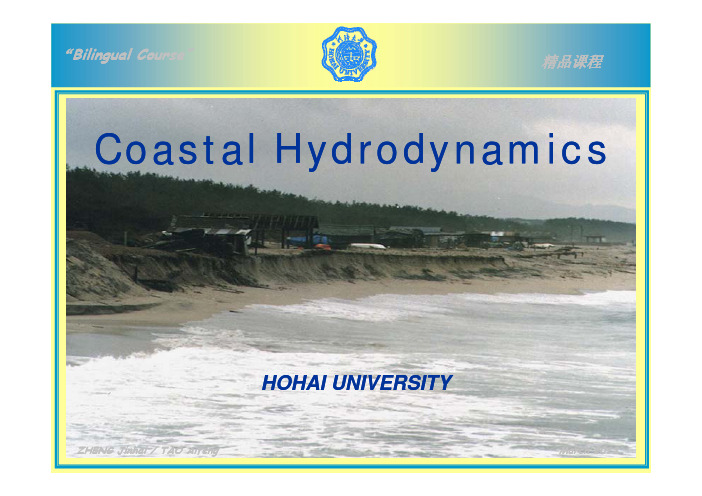
“Bilingual Course”精品课程Coastal Hydrodynamics C t l H d d iHOHAI UNIVERSITYMarch 20132013 Aifeng March Jinhai/ TAOZHENGZHENG Jinhai/ TAO AifengChapter 3 WA VE TRANSFORMATIONS Stating ocean wave characteristicsStating transformations of wavesStating transformations of wavesentering shallow water31Ocean Wave Characteristics 1S i i l h i i f§3.13.1 Ocean Wave CharacteristicsOcean Wave Characteristics1.Statistical characteristics of oceanwaves2Wave height distribution and wave2. 2. Wave height distribution and waveWave height distribution and waveperiod distribution3. 3. Ocean wave energy spectraOcean wave energy spectra4. 4. DeepDeep--water wave propagationp p p g5/39What are statistically representative waves?What are statistically representative waves?11/39Rayleigh distribution curveJONSWAP spectrumT 2RT 1Example: a separate wave group movesfrom the generation area to the coastline. 6/38If R is the distance from the leading edge of the If is the distance from the leading edge of the storm fetch to point A on the coast, then timeisduration for wave period T1, the time duration is For a short wave period T2Then we can get a warning time:ransformations in shallow water3.2 Wave transformations in shallow water §3.2 Wave tWave shoaling 1.Wave conservation 2. 2. Wave shoalingWave reflection Wave refraction 4. 4. Wave reflection 3Wave refraction4Wave reflection 3. 3. Wave refractionWave breaking Wave diffraction 6. 6. Wave breaking 5. 5. Wave diffraction5Wave diffraction6Wave breakingSeveral changes occur as a train of waves S l h t i f propagates into shallow water. One of the propagates into shallow water One of the most obvious is the change in height as the most obvious is the change in height as the wave shoals. Other changes such as the wave shoals Other changes such as the decrease in wave length with shallower decrease in wave length with shallower depths and the changes in wave direction depths and the changes in wave direction are clearly observable from the air.are clearly observable from the air.1 Conservation of wave equations The conservation of wave equation can be1.1. Conservation of wave equationsConservation of wave equations expressed asThis equation states that any temporal variation q y pof the wave number vector must be balanced by spatial changes of the wave angularf frequency.If the wave field is constant in time, the wave If th fi ld i t t i ti thperiod does not change with space, even as period does not change with space even asp gthe water depth changes.This feature is very important because it is not only of convenience for the analysis of wave motions but also provides the theoretical basis for the experimental simulationsof water waves.of water wavesWave transformation in shoaling water 2. Wave transformation in shoaling water 2 W W t f ti i h li t 2.Assuming that the energy flux is conserved in Assuming that the energy flux is conserved in the process of wave propagation, the wave the process of wave propagation,the wave height at a given water depth can beg g pdetermined by:is named the shoaling coefficient(浅水变ks形系数)Using the linear theory and recalling the dispersion l ti hi hrelationship, we haveg pIt is seen that the wave length at the water depth is determined from the water depth and deep water wave length, the latter easily calculated from the wave period.f h i dWave properties in shallow waterIt is seen that L and c decrease but n increases It is seen that and decrease but nwith decreasing depth.It can be found that there should be a small decrease in the wave height in the intermediate water depths to a value below the deep water water depths to a value below the deep water gwave height.The decrease is then followed by a rapid increase in H as shallower depths are reached.Upon entering shallow water waves are3.3. Wave refractionWave refraction Upon entering shallow water, waves aresubject to in which subject to refraction(折射折射)), in whichthe direction of wave travel changes with the direction of wave travel changes withdecreasing depth of water in such a way decreasing depth of water in such a way that the crest tend to parallel the depthp pcontours.Change of wave rayg yThe horizontal line along which waves travel波向线)),which isis called a wave ray(波向线defined as a line along which the wave number vector is always tangent.As energy travels in the direction of the wave, A t l i th di ti f ththe wave energy associated with the wave the wave energy associated with the waveg ytravels along the wave ray also.It b th tIt can be seen thatas the wavecelerity decreasesas the shore ish d thapproached, theangleαwill alsogdecrease from its Wave refraction in shallow waterdeepdeep--water value.The refraction of water wave is analogous to The refraction of water wave is analogous tog g y,gthe bending of light rays, and the change in direction is related to the change in the wave celerity through the same Snell’s law.For straight coasts with parallel contours,Change of wave heightIn the treatment of wave refraction, it is I th t t t f f ti it i assumed that no energy flows laterally assumed that no energy flows laterally along the wave crests. Therefore, the along the wave crests.Therefore,thegytransmitted wave energy is conserved between two rays as waves pass over the changing topography.Conservation of wave energy flux between two raysRecognizing that there is no energy flux across the wave rays, the energy flux across bis the th th fl i th0 same as across b.same as across.Finally we have the relationship between deep and intermediate or shallow depth water:In water with straight and parallel offshore I t ith t i ht d ll l ff h contours, it is possible for us to determine contours it is possible for us to determine the refraction coefficient(折射系数)k the refraction coefficientr directly.d ect y.g gWave convergence or divergence幅聚))refers to a Wave convergence(幅聚phenomenon that waves refract and bend toward headlands so that the wave energy isd h dl d h h i therefore concentrated.therefore concentratedgWave divergence(幅散)refers to a phenomenon that waves refract and diverge over the deep water so that the waves are reduced in height.d d i h i htWave convergence and/or divergenceWave convergenceWave convergenceor divergence dueto wave refractionis important indeciding wheredeciding whereto construct apier or otherstructure onCase study of wave refractioncoasts.Wave reflection4. Wave reflection4.At the locations of coastal structures or at places where the bottom configuration suddenly changes, a part of wave energy dd l h fis reflected and the reflected wave isis reflected and the reflected wave isggenerated.The reflected wave has the same wave period and wave length as the incident wave, but the wave height is different.b t th h i ht i diff tThe reflection coefficient is defined aswhich varies with the angle of the slope which varies with the angle of the slope,pthe incident wave steepness and the characteristics of the slope.The reflection coefficient based on the smallamplitude wave theory can be determined by lit d th b d t i d bmeasuring the amplitudes at the antinode and measuring the amplitudes at the antinode and node of the composite wave train.node of the composite wave trainoweve,t e dete at o o t e e ect o However, the determination of the reflectionp y coefficient should be conducted experimentally for a concrete engineering.Wave diffraction5.5. Wave diffractionWhen incoming waves are interrupted by a barrier such as a breakwater or an island,the waves curve around the barrier and penetrate into the sheltered area, meanwhile the wave energy is transferred laterally along a wave crest. This phenomenon l t ll l t Thi h波浪绕射)).is called wave diffraction (波浪绕射is called wave diffractionWave diffractioniff ioccurs on theoccurs on thesheltered side ofthe breakwatersuch that a waveh th tdisturbance isdisturbance istransmitted intothe “geometricshadow zone”. Wave diffraction h d”Wave diffraction绕射系数))is The diffraction coefficient(绕射系数The diffraction coefficientdefined as the ratio between the diffracted defined as the ratio between the diffracted and incident wave heights.and incident wave heights.It is clear that a quantitative understanding of the diffraction coefficient is relevant to theplanning and evaluation of harbor layouts.Numerical Modeling of Wave DiffractionW Wave Action Balance Equation with Diffraction effect 016000.25200400-0.500.1200400-0.5005200400600800100012001400200400600800100012001400“Coastal Hydrodynamics”——chapter 3ZHENG ZHENG Jinhai Jinhai / TAO / TAO Aifeng AifengMar Mar 20132013THANK YOU。
海岸动力学1-1说课讲解

2 0
0, z
z=-h
t z1 2 x2 z2zg0
0, z
t xx z
(x ,z,t) (x c,zt)
pg(流速场)
p(压力场)
两个困难
1) 2) 自由水面位移η在边界上的值是未知的,即边界条件 不是确定的。
要求得上述波动方程的边值解,最简单的方法是先将
拉格朗日法:亦称全面法,它以空间某一质点为研究对 象,研究该质点相对于初始条件的各个不同时间的位置、 速度和加速度等。拉氏法研究的是某一质点的位置变化,
(Path line).
描述规则波浪运动的理论 微幅波理论( Airy ,1845)
有限振幅波理论 ( Stokes,1847) 椭圆余弦波理论 孤立波
三、微幅波解的讨论—— 1 深水波情况
当水深h或kh为无限大,即h, kh→∞时,
tankhh )k(h 1 tankhh )(kh 0.9962
水深h大于波长L的一半,或说kh>π时,可认为 已处于深水情况。这时,波浪弥散方程可以化简为
2 gk
gT 2
L0 2
gT
c0 2
在深水情况下波长和波速与波周期有关,而与水深无关
pgz
t
p (压力场)
二、微幅波理论解——
分离变量法求解
势函数的解 g 2 H cc o k o s z k s h h h h sik n x (t)
自由水面波面 Hcosk(xt)
2
弥散关系
2 gktankhh ()
tanh-双曲正切函数, cosh-双曲余弦,sinh-双曲余弦 σ--角频率、 k--波数, h--水深
弥散方程等价关系式
2 gktankhh ()
海岸动力学复习要点

海岸动力学复习要点《海岸动力学》--复习要点第四版CQJTU1、海岸类型和海岸主要动力因素:按照岸滩的物质组成,海岸类型有(1)基岩海岸 (2)砂砾质海岸 (3)淤泥质海岸 (4)生物海岸(红树林海岸和珊瑚礁海岸) 主要动力因素有:波浪、潮汐及潮流、近岸流、台风、风暴潮、海啸、异重流;以及河流影响。
2、海岸线和海岸带的概念:海岸线是大潮平均高潮面与陆岸的交线。
海岸带是陆地与海洋相互作用、相互交界的一个地带,包括潮上带,潮间带,潮下带;潮间带指高潮时海岸线与低潮时海岸线之间的带状区域;潮上带是海岸线向陆扩展10km的区域;潮下带向海到-10m,-15m等深线。
1、波浪分类:按波浪形态分类,波浪可分为规则波和不规则波。
不规则波又称随机波。
按波浪传播海域的水深分类,波浪分为深水波、有限水深波和浅水波。
深水波时h/L?0.5浅水波时h/L?0.05(其中h为水深,L为波长),,,,akxtcos()2、谐振波波面表达式:波面表示为,则波长为,则波周期为,波速为Lk,2,T,2,,ck,,,传播方向为x方向。
3、描述规则波浪运动的理论:主要有微幅波理论、有限振幅Stokes波理论、椭圆余弦波理论,孤立波等。
4、势波理论:假定流体无粘无旋并且不可压缩,因而剪切应力为零,无摩阻损失,存在势函数,求解势波的控2制方程简化为;底部边界上,法向速度为零。
流速场和压力场可分开求解.求出速度势函数和流速场,,,,0后,由伯诺里方程求得压力场。
5(界面运动学边界条件:在流体界面上,不应有穿越界面的流动,否则界面就不能存在。
流体界面具有保持性,某一时刻位于界面上的流体质点将始终位于界面上,不能有相对法向位移,即界面上水质点运动法向速度等于界面运动法向速度。
6、线性波理论假定:波动的振幅相对于波长或水深是无限小的。
线性波水质点运动轨迹为一个封闭椭圆,其水平长半轴为a,垂直短半轴为b。
在水面处b,H/2,即为波浪的振幅,在水底处b,,,说明水质点沿水底只作水平运动。
海岸动力学课件 Coastal Dynamics_1
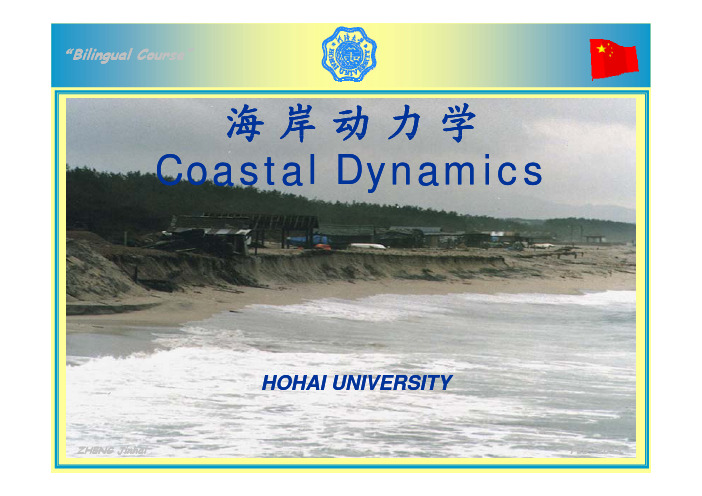
“Bilingual Course”海岸动力学 Coastal DynamicsZHENG JinhaiHOHAI UNIVERSITYFeb. 2013Harbour EngineeringWaterway Engineering分流口鱼咀南导堤北导堤 航道疏浚丁坝群Coastal Engineering石城南 工程点 日岛0m 4000m 8000mWave theoryWave transformationNearshore circulationsSediment movementsCoastaline changesWavestructure interactionsPROLOGUE1 Self-introduction 2 Teaching assumptions 3 Textbook & references1. SELF-INTRODUCTIONName: ZHENG JinhaiEducation: Ph.D. 1998Coastal Engineering, Hohai UniversityEmployment: ProfessorCollege of Harbor Coastal and Offshore Engineering Hohai UniversityResearch interest (a):) Numerical modeling of coastal and estuarine hydrodynamics16001400 3 2.51200 21000 1.5 1800 0.5600 0.25 0400 -0.5200200400600800100012001400A phase averaging prediction model for multi-directional random waves considering ambient currentsResearch interest (a):) Numerical modeling of coastal and estuarine hydrodynamicsV (cm/s)50Visser (1991, case 4)ExperimentsComputations 140Computations 2Computations 4Computations 53020100-10012345678x (m)Incorporating surface rollers into a quasi three dimensional neashore current model to explain the spatial lag between wave breaking point and location of maximum wave-induced currentResearch interest (b):) Experimental study on interactions of waves and structuresFloating Mat Breakwater in Daishan Central Fishery HarborR h i t t ()Research interest (c):Numerical Wave Flume)Numerical Wave FlumeDevelopmentofnumericalwaveflumeusingusing improvedsmoothedparticleparticle hydrodynamicsC t t t hiContact teaching group:R 503/506B ildi SKL)Room 503/506, Building SKL,14:30 to 17:30 pm, Every Wednesday.)Email: Email: jhzheng@ jhzheng@aifeng tao@gmail comaifeng.tao@ jszhang@zhangchi@gangwang@)Phone: 83786821837879142. TEACHING ASSUMPTIONS What is it ?Wh i i?Why is it important ?How to learn it ?How to learn it?What ?a t o credit biling al co rseWhat ?2months:from Feb25to Apr18a twoa two--credit bilingual course )2 months:from Feb. 25 to Apr. 18 bili l)bilingual:2languages—Chinese&English2 languages Chinese & English)bilingual teaching:bilingual teaching:3 types3 types ——immersion programmaintenance programtransitional programp gWhat ?a t o credit biling al co rse What ? a twoa two--credit bilingual course)main topics:wave theorywave transformationswave transformationsnearshore circulationssediment movementscoastal processesWhat ?a state pri e a arded co rse What ?h//l hh d/k2007a statea state--prize awarded course /jpkc2007 /jpkc2007/ h i d li/C/I d ht haiandonglixue/Course/Index.htm http://202.119.113.100:4505/ http://20211911282/scr2006 http://202.119.112.82/scr2006Why ?Students who are going to become engineersand scientists in the field of harbor, waterwayand coastal engineering should master thebasic knowledge of coastal hydrodynamics basic knowledge of coastal hydrodynamics,p ywhich will help you to avoid undesirable effectin the plan and design of coastal engineering.)technical abilities technical abilitieslanguagecultural awarenessinnovativeMaster the results of derivations How ?Master the results of derivations& their physical meanings. Regularly, Carefully, Actively, Diligentlytermterm--time performance, 10% Finapal Sc homework, 30%corefi l i ti60%final examination, 60%3. TEXTBOOK & REFERENCES 3TEXTBOOK&REFERENCES Zou Zhili(2009). Coastal Dynamics, 4th eds. Press of People’s Communication. .Press of People’s Communication2 periods for introduction10 periods for wave theory6 periods for wave transformations6i d f t f tip4 periods for nearshore circulations6 periods sediment movements4 periods for coastal processes4i d f lReferences:Yen Kai(2002)“Coastal Engineering”)Yen Kai (2002). “Coastal Engineering”.China Ocean Press.Dalrymple R. A. (2004).y p() Dean R. G. & Dalrymple)Dean R. G. &“Water Wave Mechanics for Engineers andScientists. Prentice--Hall, Inc.. PrenticePrenticeScientists”Prentice-Hall Inc)Horikawa K. (1998). “Nearshore Dynamics Horikawa K(1998)“Nearshore Dynamics and Coastal Process”. University of TokyoPress.References:海岸带环境资源与海岸工程海岸带开发利用简史海岸动力因素海岸泥沙运动与海岸演变波浪对海岸工程建筑物的作用海岸防护工程围海工程海港工程河口治理工程潮汐发电工程海岸带采油工程海岸工程现场测验海岸工程水工模型试验海岸工程数值模拟海岸工程施工References:绪论海岸动力因素海岸泥沙运动与岸滩演变波浪与海工建筑物的相互作用海岸防护工程海港工程河口治理工程海岸工程现场测验海岸工程水工模型试验海岸工程数值模拟References:References:引言海岸水动力学海岸泥沙运动海岸地质学海岸工程规划设计海岸工程结构设计海岸工程术语表ManualEngineer Manual免费版本Engineer ManualEngineer Manual免费版本免费版本/引言引言:: 手册简介、海岸分类、海岸工程史及全书概貌海岸水动力学海岸水动力学:: 波浪力学、气象与波况、近岸海浪推算、破波带水动力学、水位与长波、潮汐通道水动力学、港湾水动力学、cem026.html或水动力分析及设计条件海岸泥沙运动:海岸泥沙性质、沿岸输沙、横向输沙、风输沙、粘性沙冲刷输移及沉积、破波带外泥沙输移海岸地质学:海岸术语与地质环境、海岸地貌分类、海岸动力地貌海岸工程规划设计:规划和设计过程、航道工程、潮汐通道港湾回淤管理、/inet/ususaceace--docs/engdocs/eng--manuals 海岸环境改善工程、联邦政府的减灾工作海岸工程结构设计:海岸结构及其功能、现场特殊设计条件、工程材料与施工管理、设计原理、可行度设计、Chapter 1 INTRODUCTION Introducing characteristic features ofcoast of ChinaIntroducing development of coastal zoneresources in Chinai ChiIntroducing background information Introducing background informationof coastal engineeringIntroducing methods to study coastalhydrodynamicshydrodynamicsCharacteristic Features of1. Characteristic Features of1.1Characteristic Features ofCoast of China()y ypI)Variety of Coast Types and InnumerableIslands(II)Innumerable Rivers Emptying into thepSea and Complicated Coastal Processes (III)Vigorous Dynamic Action along the Coast (IV)Prominent Climatic Influence(I) Coast typesIn its basic sense the coastline represents the What is the coast?In its basic sense, the coastline represents the boundary between marine and terrestrial iThe coast is a dynamic environment in which environments.The coast is a dynamic environment in which land and sea are constantly interacting int t l f tresponse to external factors.“The beach is the battleground of “The real conflict is between mand S ithe shore.”____William Beebe and nature. ”____SoucieAs the beaches become even more intenselyAs the beaches become e en more intenselg p p,utilized because of increasing population,we must establish priorities in the possibleuses of the coast.(I) Coast typesFor the continental part of China, the length of tli i b t18000k d h i l di coastline is about 18000 km, and when including the coastline of 6500 islands, an overall length ofgeomorAccording to geomor--32000km may be counted.According to geomorphological features, thecoast of China may becoast of China may beclassified mainly intoil dsilty coast, sandy coast,rocky coast and coralcoast.Silty coast(淤泥质海岸)is formed chiefly due tothe supply of huge amount of fine sediment bylarge rivers. The material composing such coast large rivers.The material composing such coastis very fine, generally with grain diameter <0.06mm. The beach profile presents a very gentleslope, varying from 1/500 to 1/2000.l i f1/500t1/2000Sandy coast(沙质海岸)is formed most nearthe mouths of rivers carrying coarse sediment; the mouths of rivers carrying coarse sediment;or where wave action is so strong that finesediment is easily carried away and difficultto deposit. The grain diameter of the material to deposit The grain diameter of the material generally ranges from 0.06 to 2.0mm, with beach profile usually > 1/100.(I) Coast typesRocky coast(基岩海岸)presents irregular configuration, with numerous bays, straits and capes. n mero s ba s straits and capesOwing to the presence of great Owing to the presence of greatdepth of water and good shelteringcondition, favorable sites for port construction could be found alongsuch coast.such coast(I) Coast typesCoral coast (珊瑚礁海岸) prevails along the coastline south of the Tropic of Cancer. south of the Tropic of CancerCoral reefs are usually found around islands, such as aroundthe Hainandao, on the east and th H i d th t dsouth coast of Taiwan and atthe archipelagoes of the South China Sea.Chi S(II) Rivers emptying into the sea ()p y gAnnual di t Sediment t ti Tidal range t i th Length Name f sediment load (million t)concentration (kg/m 3)at river mouth (m)(km)of riverYangtze River6300486 0.47 2.66Yellow RiverPearl River 546422101120 83 25.200.23 1.001.26The huge amount of sediment deposited near g pthe mouths of the rivers under the action of waves and currents causes significant changes of the coastline.changes of the coastline.()y(III) Dynamic action Diversified coast types and innumerable Diversified coast types and innumerable,g griver outlets, together with scattering islands around the coast, give rise to complicated bed forms, which in turn affects the dynamic features along the coast of China.W V S NTIDE WAVE SEDIMENT()(IV) Climatic influence ¾China is a country stronglyaffected by monsoons.ff t d bIn China typhoon is of¾In China typhoon is offrequent occurrence duringsummer and autumn,p cu y o g e co sparticularly along the coastof southeastern provinces.¾China is often hit by coldwave.wave.Development of Coastal Zone2. Development of Coastal Zone2Development of Coastal Zone2.Resources in China ()Ⅰ) Coastal Resources of China(Ⅱ) Port Construction along the Coast )Port Construction along the Coast (Ⅲ) Reclamation and Land Use)R l ti d L d U(Ⅳ) Rational Utilization and Development of Coastal Resources(I) Coastal resourcesIn 1980 the State Council decided to conduct a wide Comprehensive Assessment of NationNation--wide Comprehensive Assessment of Coastal Resources along our coastline.reclaimable landreclaimable landsalt fieldstidal power oil resourcestidal powerChapter 1 aquatic breeding<IEA-OES report 2009>Chapter 1(II) Port construction(III) Land reclamation In the past 60 years, about 1.2 million ha of id l fl h b l dtidal flat have been enclosed.NEW STAGE:l i d l¾multi multi--purpose developmentf t lof coastal zone resourcesmore complicated technical ¾more complicated technicalproblems to meet withproblems to meet with(IV) Rational developmentIn the comprehensive utilization anddevelopment of coastal resources, itd l t f t l itis necessary to consider the specificcircumstances of the coastal regionconcerned, making full use of itsconcerned,making full use of itsadvantageous conditions.Meanwhile, special care should be takenof the maintenance of ecologic balanceof the maintenance of ecologic balanceand protection against pollution.ANY IGNORANCE THEREOF WILL BE PUNISHED BY NATURE3. Background Information ofCoastal Engineering Coastal engineering is a branch of civil Coastal engineering is a branch of civilengineering, which was established by the closecooperation between civil engineers andscientists in other fields such as geography scientists in other fields such as geography, oceanography and geology, etc.The term“coastal engineering”was first(I) Historical backgroundThe term coastal engineering was first introduced in Oct. 1950 at the First Conference on Coastal Engineering held at Long Beach, California, U.S.A. The early research was limited in the area of early research was limited in the area of wave prediction, wave transformation in the shallow water zone especially for ilimilitary purpose.(II) Recent trendsCoastal engineering arose from aCoastal engineering arose from astrong interest in harbor constructionand coastal protection measures.In resent years, the subjects involvedin coastal engineering have expandedto the environmental preservation oft th i t l ti fnearshore zones.the coastal and nearshorethe coastal and zones.the coastal and。
海岸动力学海岸动力学复习资料(全)

海岸动力学海岸动力学复习资料(全)处,应满足动力学边界条件运动学边2)在波面 z=,海岸动力学复习资料第一章界条件。
动力学边界条件为水面上压力为常数,因此取z=,并令p=0,得到自由表面动力学边界条件。
,1.海岸带宽度按从海岸线向内陆扩展10KM,向外海延伸到-15~-20m水深计算。
3)流场左右两端的边界条件可根据简单的波动在空间和2.海岸类型:基岩海岸,砂质海岸,淤泥质海岸,生物海时间上呈周期性来却确定。
在空间上看的波要素是相同岸。
的,在时间上看一个周期后的要素也应相等,故波场上下3.海岸的基本概念:海岸是海洋和陆地相互接触和相互作两端面边界条件可表示为用的地带,包括遭受波浪为主的海水动力作用的广阔范。
,(x,z,t),,(x,L,z,t),,(x,z,t,T)围,即从波浪所能作用到的海底,向陆延伸至暴风浪所能到达的地带。
5.建立简单波理论时,一般作如下规定:流体是均质和不4.海岸动力因素:波浪的作用、海岸波生流、潮流的作可压缩的,其密度为常数;流体是无粘性的理想液体;自用、径流的作用、海流的作用、风暴潮和海啸、风的作用、由水面的压力是均匀的且为常数;水流运动是无旋的;海海平面上升。
底水平、不透水;质量力仅为重力,表面张力和柯氏力可5.波浪是引起海岸变化的主要因素。
忽略不计;波浪属于平面运动,在xz平面内坐二维运动。
6.近岸波生流——波浪传至近岸地区发生变形、折射与破6.微幅波理论的控制方程和定解条件22碎,不仅其尺度改变了,同时还形成的一定水体流. ,,,, 控制方程: ,,022,x,z7.沿岸流——斜向入射的波浪进入海滨地带后,在破波带引起一股与海岸平行的平均流。
8.裂流流速很高,会带动强烈的向外海输移的泥沙运动。
,,定解条件:海底部边界条件: z=-h ,09.潮流对海岸的作用:影响海岸带波浪的作用范围及作用,t强度;影响海岸带地貌类型的发育;潮流流速影响海岸带自由水面处: 1,,的侵蚀与淤积。
- 1、下载文档前请自行甄别文档内容的完整性,平台不提供额外的编辑、内容补充、找答案等附加服务。
- 2、"仅部分预览"的文档,不可在线预览部分如存在完整性等问题,可反馈申请退款(可完整预览的文档不适用该条件!)。
- 3、如文档侵犯您的权益,请联系客服反馈,我们会尽快为您处理(人工客服工作时间:9:00-18:30)。
第一章1.1 建立简单波浪理论时,一般作了哪些假设?1.2 试写出波浪运动基本方程和定解条件,并说明其意义。
1.3 试写出微幅波理论的基本方程和定解条件,并说明其意义及求解方法。
1.4 线性波的势函数为()[]()()t kx kh z h k gh σσφ-+=sin cosh cosh 2证明上式也可写为()[]()()t kx kh z h k Hc σφ-+=sin sinh cosh 2 1.5 由线性波的势函数证明水质点轨迹速度()[]()()t kx kh z h k TH u σπ-+=cos sinh cosh ()[]()()t kx kh z h k T H σπω-+=sin sinh sinh并绘出相位()t kx σ-=0~2π时自由表面处的质点轨迹速度变化曲线以及相位等于0,π/2,π,3π/2和2π时质点轨迹速度沿水深分布。
1.6 试根据弥散方程,编制一已知周期T 和水深h 计算波长、波数和波速的程序,并计算出T =9s ,h 分别为25m 和15m 处的波长和波速。
1.7 证明只有水深无限深时,水质点运动轨迹才是圆。
1.8 证明线性波单位水柱体内的平均势能和动能为2161gH ρ。
1.9 在水深为20m 处,波高H =1m ,周期T =5s ,用线性波理论计算深度z =–2m 、–5m 、–10m 处水质点轨迹直径。
1.10 在水深为10m 处,波高H =1m ,周期T =6s ,用线性波理论计算深度z =–2m 、–5m 、–10m 处水质点轨迹直径。
1.1在某水深处的海底设置压力式波高仪,测得周期T =5s ,最大压力2max /85250m N p =(包括静水压力,但不包括大气压力),最小压力2min /76250m N p =,问当地水深、波高是多少?1.12 若波浪由深水正向传到岸边,深水波高m H 20=,周期s T 10=,问传到lkm 长的海岸上的波浪能量(以功率计)有多少?设波浪在传播中不损失能量。
1.13 在水深为5m 处,波高m H 1=,周期s T 8=,试绘出二阶斯托克斯波与线性波的波剖面曲线及近底水质点速度变化曲线并比较之。
1.14 如果二阶斯托克斯波η的附加项(非线性项)的振幅小于线性项的5%时,可以略去附加项而应用线性波理论,问在深水处应用线性波理论的最大允许波陡是多大?在相对水深h /L =0.2处应用线性波理论的最大允许波陡又是多大。
1.15 在水深为5m 处,m H 1=,s T 8=,试计算斯托克斯质量输移速度沿水深的分布并计算单位长度波峰线上的质量输移流量。
1.16 试述波浪频谱和波浪方向谱的意义。
1.17 已知一波浪系列的有效波高s H 为4.7m ,有效波周期为4.7s ,问该波列的平均波高是多少?大于6m 的波高出现的机率是多少?第二章2.1 试述波浪守恒和波能守恒的意义?何谓波浪浅水变形?2.2 何谓波浪折射?斯奈尔折射定律意义何在?2.3 若深水波高厅s H = lm ,周期T = 5s ,深水波向角0045=α,等深线全部平行,波浪在传播中不损失能量,计算在水深h = 10m 、5m 、2m 处的波高(用线性波理论)。
2.4 上题中求水深h = 10rn 、5m 、2m 处底部水质点轨迹速度的最大值及床面剪切应力的最大值,假定床面平坦,泥沙粒径D =0.01mm 。
2.5 若深水波高厅m H 10=,周期T = 10s ,等深线全部平行,波浪正向入射,波浪在传播中不损失能量,分别用线性波理论及考虑非线性影响(用岩垣公式)求水深h = 2m 处的波高。
2,6 若波浪由深水正向传到浅水,深水波高为0H ,周期为T ,海床底坡为m ,波浪没有折射,但必须考虑底部摩阻损失,已知摩阻系数为w f ,试编制一计算浅水中任一点的波高的程序。
2.7 当波浪斜向进入浅水区时,若海底等深线平行,证明:两相邻波向线在任意水深处所截的等深线段为常数,由此证明任意点的折射系数ααcos cos 0=r k其中0α为深水波向角,α为该点的波向角。
2.8 在深水中,1s 、5s 、10s 周期的波浪不破碎可能达到的最大波高是多大?在水深为10m 处及水深为lm 处可能达到的最大波高各为多大?设海滩坡度极为平缓。
2.9 若海滩波度为1/20,深水波高厅m H 10=,周期T = 5s ,等深线完全平行,求波浪正向入射时,波浪在海滩上破碎时的破波水深及破波高。
2.10 上题若波浪斜向入射,深水波向角0α=450,求破波水深及破波高。
2.11 一个波流共存场,已知水深h = 20m ,无流时的波周期s T s 10=,波高m H s 2=,波浪传播方向与水流方向夹角为1500,试求出波流共存时的波长、波速和波高。
第三章3.1 近岸流方程是如何得到的?简述方程中各项的物理意义。
3.2 简述辐射应力在浅水区和破波带的变化规律。
3.3 波浪增减水是如何发生的?3.4 波浪斜向入射平直海滩时沿岸流的生成机理是什么?3.5 假定波浪斜向入射平直海岸,等深线相互平行,深水波角为0α,深水波高为0H ,试根据能量守恒和Snell 定律导出破波带外平均水位()x η的表达式。
3.6 波浪斜向入射平直海岸,等深线相互平行,试证明破波带外从深水到浅水xy S 沿程不变。
3.7 若等深线平行,深水波高m H 20=,周期s T 8=,深水波角0α=300,海滩坡度m = 1/30,问碎波带内平均沿岸流流速有多大? 3.8 上题若取()35.01=-=f C m K N P γπ,摩阻系数01.0=f C ,若考虑侧向混合影响,计算沿岸流流速在海滩横断面上的分布。
3.9 假定海滩坡度均匀一致,岸线平直,波浪正向入射,沿岸方向波高不等,破波高度的沿岸梯度y H b∂∂为已知。
垂直于岸线的流速可忽略不计,不考虑侧向掺混。
试根据沿岸流控制方程,导出沿岸流速度表达式。
第四章4.1 平衡潮理论和实际潮汐的差异是由哪些因素造成的/4.2 简述地球自转对外海潮流的影响。
4.3 简述自转力对河口潮汐和潮流的影响。
4.4 潮波进入河口后会发生哪些变化?4.5 简述潮波在大陆架的传播特征。
4.6 无潮点是如何形成的?4.7 半封闭狭长海湾发生共振的条件是什么?如湾口开边界处外海潮波周期为 12.4h ,海湾水深为50m ,那么海湾长度为多大时会发生共振?简述共振时海湾内水面变化特征。
4.8 河口的宽度和深度向口门方向呈线性缓慢增加,在口门l x =处,0h h =,0B B =,()t H t σηcos 2=。
试确定河口水面的沿程变化。
4.9 有一狭长海峡,宽为30km ,长为766km ,水深沿程不变为30m ,海峡地处北纬350,该处潮汐为正规半日潮,周期为12h25min ,潮波振幅m 5.10=η,传播方向自海峡左端传向右端。
若将x 轴置于海峡中心线,原点置于海峡左端,试求该自由潮波(不考虑摩阻影响)受地转影响后,在y = 0,± 7.5,±15km 处的凯尔文波的振幅及潮流速最大值。
4.10 上题中如果将海峡在右端(x = 766km)处封闭,试绘出海峡内的同潮时线及等振幅线。
4.11 海峡中自由潮波考虑摩阻(不考虑地转影响)时,达西一韦斯巴赫摩阻系数为 0.25×10―5,用题4.9中的数据,计算:(a)在x = 766km 处的潮波振幅及潮流流速最大值;(b)潮流和潮位的相位差;(c)潮波波长及传播速度。
第五章5.1 简述波浪从深水经浅水到岸边的传播过程中,泥沙运动方式的变化过程。
5.2 简述沙纹床面上泥沙悬浮的基本机理。
5.3 波浪作用下床面泥沙受到哪些作用力?5.4 波浪作用下推移质输沙的准稳定流模型的物理意义是什么?5.5 简述沙纹波长与波浪水质点运动轨迹直径的比值对泥沙运动的影响。
5.6 影响离岸一向岸输沙方向的主要因素有哪些?5.7 破波作用下含沙量垂向分布的特点是什么?5.8 “载沙量”的物理含义是什么?5.9 波浪正向入射海岸,波高为3m ,周期为15s 。
在水深20m 处,波浪作用下泥沙起动的最大粒径为多大(v = 10—6m 2/s)?5.10 海床泥沙粒径D = 0.2mm ,深水波高m H 20=,周期为5s ,波浪无折射,问泥沙在多大深度上开始运动?5.11 在8m 水深处,波高为2.5m ,周期为8s ,泥沙粒径0.4mm ,床面为平坦,问泥沙是否起动?若当地有一与波向相垂直的宽度为200m 的挖槽,问一昼夜槽内的泥沙平均淤积厚度是多少(淤积后泥沙的空隙率为0.4)?5.12 上题若波浪水质点速度用二阶斯托克斯波理论计算,仅考虑波浪水质点速度不对称的影响,问单位长度波峰线上的推移质输沙率是多少(按淤积状态的体积输沙率计)?5.13 层移运动发生的界限是M = 240,若海滩波度为1/30,泥沙粒径D = 0.2mm ,破波高为2m ,破波水深为2.5m ,问碎波带内多大宽度范围内的泥沙运动为层移运动?5.14 在6m 水深处,波高H = 2m ,周期T = 5s ,床面平坦,泥沙粒径D = 0.1mm(沉速s m /009.0=ω),0075.0=ωf ,求悬移质含沙量(以kg /m 3计)沿水深的分布。
5.15 上题中若潮流速u c = 0.8m /s (沿水深平均流速),用贝克尔方法计算潮流与波浪共同作用的全沙输沙率,沙纹因子μ取1。
5.16 波高为3m ,周期为15s 的波浪在水深为20m 的水平底上传播,泥沙中值粒径为0.8m 。
稳定流方向与波向垂直,其表面速度为o .4m /s ,试计算悬移质输沙率和总输沙率。
第六章6.1 某海滩坡度为1/20,深水波高H 0 = 2m ,周期T = l0s ,组成海滩的泥沙粒径为0.4mm 。
试用不同方法判断该海滩剖面的最终形式及泥沙向离岸运动的情况。
6.2 某平直海岸修建一长500m 的突堤,试根据以下条件求岸线变形情况(1)已知滩肩顶面标高为+2m ,泥沙发生全面移动处的界限水深为8m ,深水波条件为H 0 = 0.5m ,T =5s ,α0 = 300。
试根据一线模型理论解求建堤3年后的岸线位置,并求上游淤积到达突堤堤头的时间。
已知式(6-23)中的系数K 可采用第五章中的沿岸输沙率公式确定。
(2)如果沿岸输沙上游侧还有河流来沙,其供沙率为10万m 3/yr ,且河流来沙中占总重20%的颗粒小于海滩泥沙的最小粒径。
试编制计算机程序求建堤1年后的岸线位置。
